David Montero
Earth System Data Cubes: Avenues for advancing Earth system research
Aug 05, 2024Abstract:Recent advancements in Earth system science have been marked by the exponential increase in the availability of diverse, multivariate datasets characterised by moderate to high spatio-temporal resolutions. Earth System Data Cubes (ESDCs) have emerged as one suitable solution for transforming this flood of data into a simple yet robust data structure. ESDCs achieve this by organising data into an analysis-ready format aligned with a spatio-temporal grid, facilitating user-friendly analysis and diminishing the need for extensive technical data processing knowledge. Despite these significant benefits, the completion of the entire ESDC life cycle remains a challenging task. Obstacles are not only of a technical nature but also relate to domain-specific problems in Earth system research. There exist barriers to realising the full potential of data collections in light of novel cloud-based technologies, particularly in curating data tailored for specific application domains. These include transforming data to conform to a spatio-temporal grid with minimum distortions and managing complexities such as spatio-temporal autocorrelation issues. Addressing these challenges is pivotal for the effective application of Artificial Intelligence (AI) approaches. Furthermore, adhering to open science principles for data dissemination, reproducibility, visualisation, and reuse is crucial for fostering sustainable research. Overcoming these challenges offers a substantial opportunity to advance data-driven Earth system research, unlocking the full potential of an integrated, multidimensional view of Earth system processes. This is particularly true when such research is coupled with innovative research paradigms and technological progress.
DeepExtremeCubes: Integrating Earth system spatio-temporal data for impact assessment of climate extremes
Jun 26, 2024


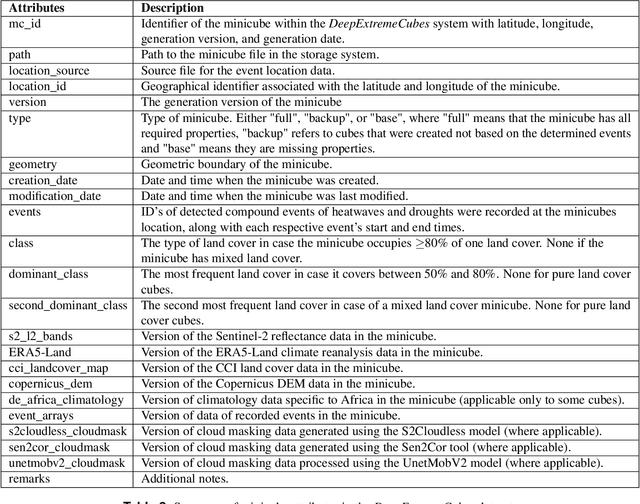
Abstract:With climate extremes' rising frequency and intensity, robust analytical tools are crucial to predict their impacts on terrestrial ecosystems. Machine learning techniques show promise but require well-structured, high-quality, and curated analysis-ready datasets. Earth observation datasets comprehensively monitor ecosystem dynamics and responses to climatic extremes, yet the data complexity can challenge the effectiveness of machine learning models. Despite recent progress in deep learning to ecosystem monitoring, there is a need for datasets specifically designed to analyse compound heatwave and drought extreme impact. Here, we introduce the DeepExtremeCubes database, tailored to map around these extremes, focusing on persistent natural vegetation. It comprises over 40,000 spatially sampled small data cubes (i.e. minicubes) globally, with a spatial coverage of 2.5 by 2.5 km. Each minicube includes (i) Sentinel-2 L2A images, (ii) ERA5-Land variables and generated extreme event cube covering 2016 to 2022, and (iii) ancillary land cover and topography maps. The paper aims to (1) streamline data accessibility, structuring, pre-processing, and enhance scientific reproducibility, and (2) facilitate biosphere dynamics forecasting in response to compound extremes.
Facilitating Advanced Sentinel-2 Analysis Through a Simplified Computation of Nadir BRDF Adjusted Reflectance
Apr 24, 2024
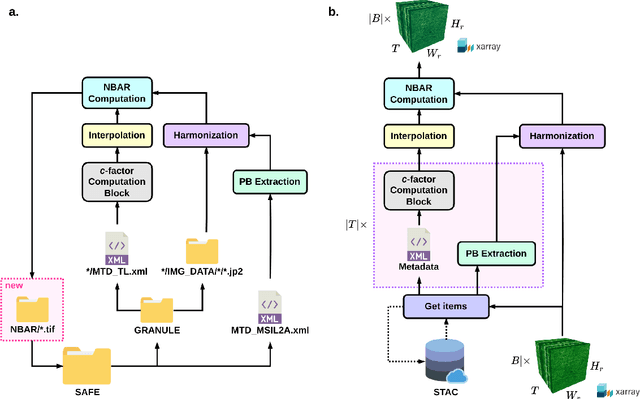

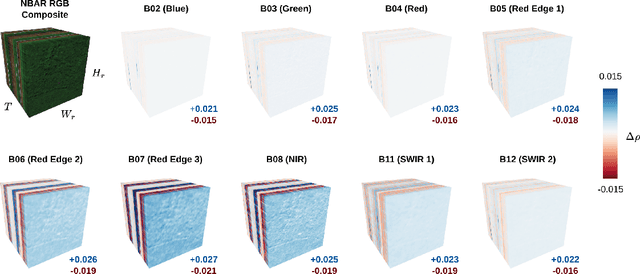
Abstract:The Sentinel-2 (S2) mission from the European Space Agency's Copernicus program provides essential data for Earth surface analysis. Its Level-2A products deliver high-to-medium resolution (10-60 m) surface reflectance (SR) data through the MultiSpectral Instrument (MSI). To enhance the accuracy and comparability of SR data, adjustments simulating a nadir viewing perspective are essential. These corrections address the anisotropic nature of SR and the variability in sun and observation angles, ensuring consistent image comparisons over time and under different conditions. The $c$-factor method, a simple yet effective algorithm, adjusts observed S2 SR by using the MODIS BRDF model to achieve Nadir BRDF Adjusted Reflectance (NBAR). Despite the straightforward application of the $c$-factor to individual images, a cohesive Python framework for its application across multiple S2 images and Earth System Data Cubes (ESDCs) from cloud-stored data has been lacking. Here we introduce sen2nbar, a Python package crafted to convert S2 SR data to NBAR, supporting both individual images and ESDCs derived from cloud-stored data. This package simplifies the conversion of S2 SR data to NBAR via a single function, organized into modules for efficient process management. By facilitating NBAR conversion for both SAFE files and ESDCs from SpatioTemporal Asset Catalogs (STAC), sen2nbar is developed as a flexible tool that can handle diverse data format requirements. We anticipate that sen2nbar will considerably contribute to the standardization and harmonization of S2 data, offering a robust solution for a diverse range of users across various applications. sen2nbar is an open-source tool available at https://github.com/ESDS-Leipzig/sen2nbar.
On-Demand Earth System Data Cubes
Apr 19, 2024



Abstract:Advancements in Earth system science have seen a surge in diverse datasets. Earth System Data Cubes (ESDCs) have been introduced to efficiently handle this influx of high-dimensional data. ESDCs offer a structured, intuitive framework for data analysis, organising information within spatio-temporal grids. The structured nature of ESDCs unlocks significant opportunities for Artificial Intelligence (AI) applications. By providing well-organised data, ESDCs are ideally suited for a wide range of sophisticated AI-driven tasks. An automated framework for creating AI-focused ESDCs with minimal user input could significantly accelerate the generation of task-specific training data. Here we introduce cubo, an open-source Python tool designed for easy generation of AI-focused ESDCs. Utilising collections in SpatioTemporal Asset Catalogs (STAC) that are stored as Cloud Optimised GeoTIFFs (COGs), cubo efficiently creates ESDCs, requiring only central coordinates, spatial resolution, edge size, and time range.
Recurrent Neural Networks for Modelling Gross Primary Production
Apr 19, 2024


Abstract:Accurate quantification of Gross Primary Production (GPP) is crucial for understanding terrestrial carbon dynamics. It represents the largest atmosphere-to-land CO$_2$ flux, especially significant for forests. Eddy Covariance (EC) measurements are widely used for ecosystem-scale GPP quantification but are globally sparse. In areas lacking local EC measurements, remote sensing (RS) data are typically utilised to estimate GPP after statistically relating them to in-situ data. Deep learning offers novel perspectives, and the potential of recurrent neural network architectures for estimating daily GPP remains underexplored. This study presents a comparative analysis of three architectures: Recurrent Neural Networks (RNNs), Gated Recurrent Units (GRUs), and Long-Short Term Memory (LSTMs). Our findings reveal comparable performance across all models for full-year and growing season predictions. Notably, LSTMs outperform in predicting climate-induced GPP extremes. Furthermore, our analysis highlights the importance of incorporating radiation and RS inputs (optical, temperature, and radar) for accurate GPP predictions, particularly during climate extremes.
CompactifAI: Extreme Compression of Large Language Models using Quantum-Inspired Tensor Networks
Jan 25, 2024


Abstract:Large Language Models (LLMs) such as ChatGPT and LlaMA are advancing rapidly in generative Artificial Intelligence (AI), but their immense size poses significant challenges, such as huge training and inference costs, substantial energy demands, and limitations for on-site deployment. Traditional compression methods such as pruning, distillation, and low-rank approximation focus on reducing the effective number of neurons in the network, while quantization focuses on reducing the numerical precision of individual weights to reduce the model size while keeping the number of neurons fixed. While these compression methods have been relatively successful in practice, there's no compelling reason to believe that truncating the number of neurons is an optimal strategy. In this context, this paper introduces CompactifAI, an innovative LLM compression approach using quantum-inspired Tensor Networks that focuses on the model's correlation space instead, allowing for a more controlled, refined and interpretable model compression. Our method is versatile and can be implemented with - or on top of - other compression techniques. As a benchmark, we demonstrate that CompactifAI alone enables compression of the LlaMA-2 7B model to only $30\%$ of its original size while recovering over $90\%$ of the original accuracy after a brief distributed retraining.
MFR 2021: Masked Face Recognition Competition
Jun 29, 2021

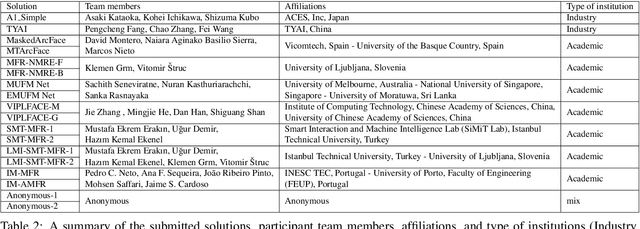
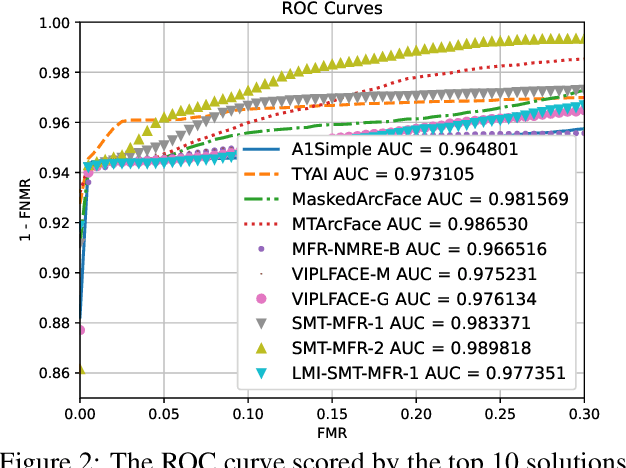
Abstract:This paper presents a summary of the Masked Face Recognition Competitions (MFR) held within the 2021 International Joint Conference on Biometrics (IJCB 2021). The competition attracted a total of 10 participating teams with valid submissions. The affiliations of these teams are diverse and associated with academia and industry in nine different countries. These teams successfully submitted 18 valid solutions. The competition is designed to motivate solutions aiming at enhancing the face recognition accuracy of masked faces. Moreover, the competition considered the deployability of the proposed solutions by taking the compactness of the face recognition models into account. A private dataset representing a collaborative, multi-session, real masked, capture scenario is used to evaluate the submitted solutions. In comparison to one of the top-performing academic face recognition solutions, 10 out of the 18 submitted solutions did score higher masked face verification accuracy.
Learning to Automatically Catch Potholes in Worldwide Road Scene Images
May 18, 2021



Abstract:Among several road hazards that are present in any paved way in the world, potholes are one of the most annoying and also involving higher maintenance costs. There exists an increasing interest on the automated detection of these hazards enabled by technological and research progress. Our research work tackled the challenge of pothole detection from images of real world road scenes. The main novelty resides on the application of the latest progress in AI to learn the visual appearance of potholes. We built a large dataset of images with pothole annotations. They contained road scenes from different cities in the world, taken with different cameras, vehicles and viewpoints under varied environmental conditions. Then, we fine-tuned four different object detection models based on Faster R-CNN and SSD deep neural networks. We achieved high average precision and the pothole detector was tested on the Nvidia DrivePX2 platform with GPGPU capability, which can be embedded on vehicles. Moreover, it was deployed on a real vehicle to notify the detected potholes to a given IoT platform as part of AUTOPILOT H2020 project.
Boosting Masked Face Recognition with Multi-Task ArcFace
Apr 21, 2021



Abstract:In this paper, we address the problem of face recognition with masks. Given the global health crisis caused by COVID-19, mouth and nose-covering masks have become an essential everyday-clothing-accessory. This sanitary measure has put the state-of-the-art face recognition models on the ropes since they have not been designed to work with masked faces. In addition, the need has arisen for applications capable of detecting whether the subjects are wearing masks to control the spread of the virus. To overcome these problems a full training pipeline is presented based on the ArcFace work, with several modifications for the backbone and the loss function. From the original face-recognition dataset, a masked version is generated using data augmentation, and both datasets are combined during the training process. The selected network, based on ResNet-50, is modified to also output the probability of mask usage without adding any computational cost. Furthermore, the ArcFace loss is combined with the mask-usage classification loss, resulting in a new function named Multi-Task ArcFace (MTArcFace). Experimental results show that the proposed approach highly boosts the original model accuracy when dealing with masked faces, while preserving almost the same accuracy on the original non-masked datasets. Furthermore, it achieves an average accuracy of 99.78% in mask-usage classification.
Efficient Large-Scale Face Clustering Using an Online Mixture of Gaussians
Mar 31, 2021



Abstract:In this work, we address the problem of large-scale online face clustering: given a continuous stream of unknown faces, create a database grouping the incoming faces by their identity. The database must be updated every time a new face arrives. In addition, the solution must be efficient, accurate and scalable. For this purpose, we present an online gaussian mixture-based clustering method (OGMC). The key idea of this method is the proposal that an identity can be represented by more than just one distribution or cluster. Using feature vectors (f-vectors) extracted from the incoming faces, OGMC generates clusters that may be connected to others depending on their proximity and their robustness. Every time a cluster is updated with a new sample, its connections are also updated. With this approach, we reduce the dependency of the clustering process on the order and the size of the incoming data and we are able to deal with complex data distributions. Experimental results show that the proposed approach outperforms state-of-the-art clustering methods on large-scale face clustering benchmarks not only in accuracy, but also in efficiency and scalability.
 Add to Chrome
Add to Chrome Add to Firefox
Add to Firefox Add to Edge
Add to Edge